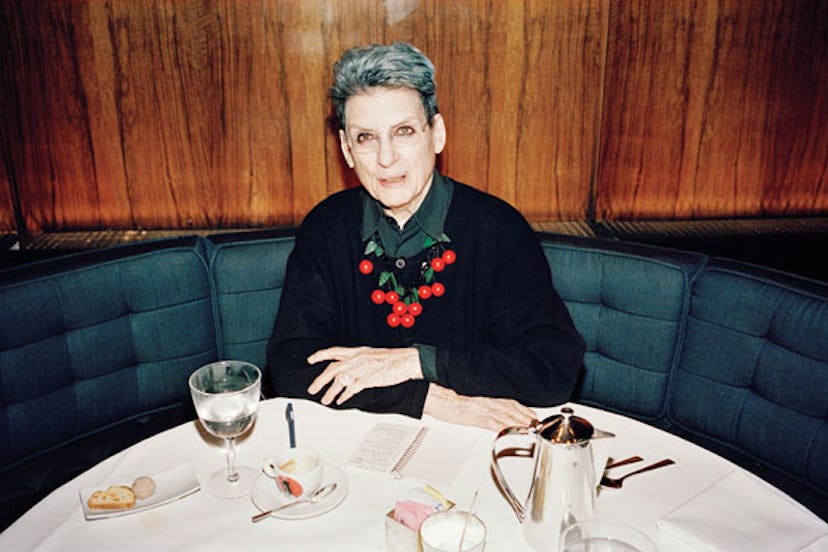It’s the rare book that saves its fireworks for the appendix. But in Phyllis Lambert’s Building Seagram (Yale University Press), that’s where you’ll find the urgent letter she wrote to her father, the Canadian liquor tycoon Samuel Bronfman, demanding that he choose a better architect for the skyscraper he was planning to build on New York’s Park Avenue. Lambert had just seen a rendering of the design her father had commissioned and found it “horrifying,” she recalls in the book. Pounding the keys of her typewriter, she wrote “no, no, no, no,” insisting he rethink his choice. “It is quiet elegance, harmony, sobriety, humility that makes beauty, not flashiness,” she scrawled in the margin.
Lambert was 27 then, living in Paris and studying sculpture. But her marriage to the French banker Baron Jean Lambert had ended, and she decided to fly to New York to find her father an architect as ambitious as he was. (Bronfman first offered Lambert the chance to choose only the marble, to which she replied, “Then you won’t have a daughter.”) Stateside, she interviewed everyone from Eero Saarinen to I.M. Pei and considered Frank Lloyd Wright and Le Corbusier, before settling on Ludwig Mies van der Rohe, the imperious German émigré, whom his protégé Philip Johnson described as “a groan-and-grunt man.” The two met in Chicago near Mies’s apartment. “Mies was profoundly generous and charming,” she recalls. “One sensed the inner integrity and the greatness of the man.”
Ludwig Mies van der Rohe and Lambert with the model for the Seagram Building, New York, 1955.
As Seagram’s director of planning, Lambert visited the site daily. “I had intended to go back to Paris, but I stayed in New York, convinced that if the one person who really cared about the building was not there, Mies would not build Seagram,” she says. With Lambert as his protector and Johnson as his assistant, Mies went on to create in 1958 the Seagram building, a landmark of 20th-century architecture.
It’s still her baby, as she makes clear during lunch in the building’s storied Four Seasons restaurant, where we meet on a February day. Though the place is best known for its power-lunch crowd, Lambert is more interested in the power of its design. “Mies took the column out of the middle there and set up this great room,” she says. But while she is in a restaurant where entrées can cost upwards of $65, her heart is outside, in the plaza, which is open to anyone, free of charge. “I’ve always cared not so much about the building but about how it impacts the life of the city,” she says. Pre-Seagram, buildings began at the sidewalk; Mies set his tower back from the street, creating an open space where the public can congregate. The idea has been imitated all over the world, changing urban design forever.
The completed skyscraper, designed by Mies and Philip Johnson, New York, 1958.
Little of the real world intruded on Lambert’s childhood in Montreal; she says she ventured out from the family’s estate for riding lessons or to attend synagogue, where, as a tycoon’s daughter, she was stared at. Her father’s strong personality and fierce temper terrified her.
But though she may have inherited her father’s drive, Lambert was never given the chance to run his liquor empire. “It was clear the dice were loaded in favor of the boys,” she tells me, referring to her kid brothers Edgar and Charles. Instead, she studied architecture (under Mies, once the project was finished), while Edgar and then her nephew Edgar Jr. ran the company. After a series of bad investments, Seagram was sold for parts in 2000. In the end, it was Lambert who created the only lasting monument to the company.
Today Lambert lives alone in a former dried-fruit factory in Montreal and runs the Canadian Centre for Architecture (CCA), perhaps the world’s most carefully curated architecture museum. Known as Joan of Architecture for her efforts to preserve the city’s historic buildings, she has worked as an architect, patron, photographer, writer, museum director, curator, and philanthropist. Small wonder then that Johnson once called her “a woman of enormous energy, of fantastic single-mindedness almost to the point of absurdity.” Though she used to show up to work at the CCA in mechanic-style coveralls, this afternoon she is dressed in a black pantsuit, wearing a necklace of plastic cherries. Most striking is her hair, a mix of golds and grays in a flat-sided coif of deliberate roughness; Lambert has cut it herself for more than 60 years. It’s a habit that arose from her dislike, as a teenage socialite-in-training, of interminable salon appointments. “At the end, I’d look in a mirror and not recognize myself,” she says. “I hated all the gossip.”
Lambert began writing Building Seagram in part to correct the record about Johnson’s role, thinking he had inflated it. (Johnson was a world-class self-promoter.) But after extensive research, she decided that his work on its lighting and interiors was, in fact, central to the building’s success. I ask how the Four Seasons looks to her these days. Well, she replies, some of the metal balusters along the grand stairway are bent, and in the Grill Room, ill-chosen bulbs are reflecting too brightly off the walnut paneling. No doubt, if Lambert has anything to do with it, the lighting will be improved by the time she’s feted in the room in May, at the launch party for the book. Still, she confesses, she’d rather be attending a symposium. Unlike a party, Lambert adds pointedly, a symposium “leaves you with something”—as, of course, does a nearly perfect building.
Photographed by Graeme Mitchell; From “The Birth of a building,” Seagram Spotlight, 1955, courtesy of Fonds Phyllis Lambert, Canadian Centre for Architecture, Montreal; Canadian Centre for Architecture, Montreal, Ezra Stoller © Esto; Fonds Seagram Building, Canadian Centre for Architecture, Montreal and Courtesy of Paula Cooper Gallery, New York, © Joel Shapiro/SODRAC, 2013
